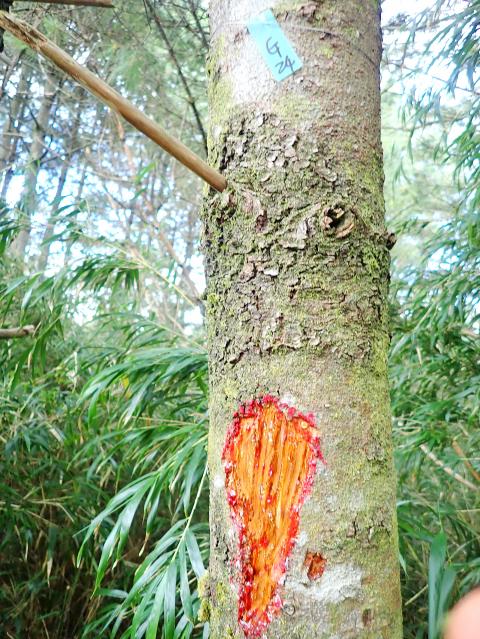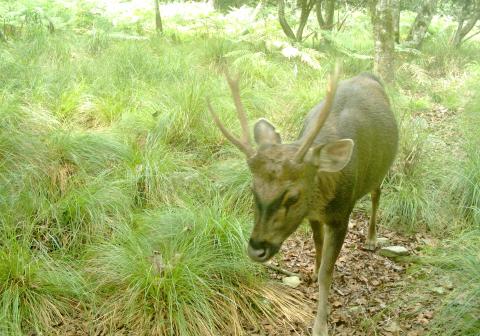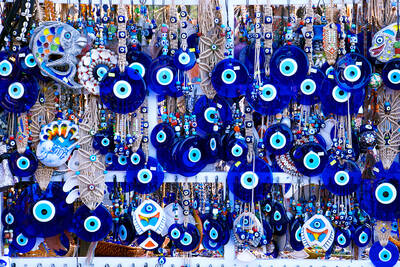For the past few years sambar in Yushan National Park have been found gnawing bark off trees, sometimes “girdling” the entire tree by gnawing the bark along its entire circumference, cutting off the transmission of nutrients and killing the tree. The park administration opened up an investigation into the problem. Preliminary findings point to the sambar needing calcium for the growth of their antlers, and stripping the tree bark to supplement the nutrient. The exact reason for this still requires further analysis. Future research will also look into how to address the problem, and how to avoid trees dying because their bark is being stripped, altering the forest physiognomy and ecology.
The park administration says it has been investigating the problem of sambar gnawing tree bark along the Nanzih Siansi Forest Road in the park area. Research focusing on the Red Cypress coniferous trees has discovered that the gnawing occurs mostly between March and May, during the spring.
This period, between March and May, coincides with the time the antlers of the park’s sambars are hardening. It is at this time that they need calcium, and this nutrient is found in the bark of the Red Cypress coniferous trees. It is thought that the sambars are gnawing the bark to obtain calcium. To protect the trees in the park, animal salt blocks are being placed in the area, to provide for the sambars’ nutritional needs. It is hoped that this measure will reduce the bark stripping.

Photo courtesy of Yushan National Park
照片:玉管處提供
Another investigation has been taking place in the Tataka area of the park over the past few years. The initial findings of this investigation is that the bark gnawing is occurring in the period from May through November, mostly in the summer and fall, different from the time in the Nanzih Siansi Forest Road area.
In the future, the height above sea level and the forest physiognomy of the two areas will be compared, to clarify what is producing the different bark gnawing behavior. This could be because the sambar herds are migrating through the areas. This information will be used as a reference for future forest conservation efforts.
(Translated by Paul Cooper, Taipei Times)

Photo courtesy of Yushan National Park
照片:玉管處提供
玉山國家公園近年出現水鹿啃咬樹皮的情況,更有部分樹木遭「環狀剝皮」,無法輸送養分而死亡。玉山國家公園管理處展開調查,初判是水鹿長硬角時需要鈣質,才會啃咬樹皮補充養分,但詳細原因仍要分析,未來將會研議如何因應,避免樹木遭啃食死亡,影響林相與生態。
玉管處說,近年在園區楠溪林道進行水鹿啃咬樹皮的調查,針對紅檜針葉樹做研究,發現啃咬時間集中在三到五月,屬於春天季節。
該區水鹿從茸角轉換硬角的時期,大約就是三到五月,此時需要鈣質養分,而紅檜樹皮具有這樣的成分,推測水鹿是為補鈣才啃咬樹皮。為保護該區樹木,將研議投放動物鹽塊補充水鹿所需,盼能減緩啃樹皮的情況。
除了楠溪林道,近年在塔塔加園區也進行水鹿啃咬樹皮的調查,初步研究則發現,出現啃咬樹皮季節分布在五至十一月,以夏秋為主,與楠溪林道的結果有所不同。
未來將會就兩地的海拔與林相做比對,釐清是何種原因產生不同的樹皮啃咬態樣,甚或是因水鹿族群遷徙所造成,藉此作為日後園區樹木生態保護的參考。
(自由時報記者劉濱銓)

Rice is essential to Japanese culture, tradition and politics. People take pride in the oval-shaped sticky Japonica grain, which is still a staple even though total consumption has fallen over the decades. But since last summer, prices have soared as supplies have fallen short of demand. The government has long paid farmers to cut back on rice acreage, and change to other crops to keep rice prices relatively high. To cope with shortfalls this year, the government has released rice reserves. But the grain has been slow to reach supermarket shelves. Anger over that was part of the reason the Agriculture Minister

Step into any corner of Turkiye, and you’ll likely encounter the iconic “Evil Eye,” known as “nazar boncu?u” in Turkish. This striking blue glass ornament is shaped like an eye with concentric circles of dark blue, white, and light blue. While its name in English suggests something threatening, it’s actually a charm designed to ward off misfortune. The origins of the nazar boncu?u can be traced back to ancient Mediterranean and Middle Eastern traditions. The word nazar comes from Arabic, meaning “gaze,” while boncu?u translates to “bead” in Turkish. Central to the nazar boncu?u’s mythology is the idea that

A: Wow, Les Miserables Staged Concert Spectacular is visiting Taiwan for the first time. B: Isn’t Les Miserables often praised as one of the world’s four greatest musicals? A: Yup. Its concert is touring Taipei from tonight to July 6, and Kaohsiung between July 10 and 27. B: The English version of the French musical, based on writer Victor Hugo’s masterpiece, has been a huge success throughout the four decades since its debut in 1985. A: The musical has never toured Taiwan, but going to the concert sounds like fun, too. A: 哇,音樂劇《悲慘世界》紀念版音樂會首度來台巡演! B: 《悲慘世界》……它不是常被譽為全球四大名劇之一嗎? A: 對啊音樂會將從今晚到7月6日在台北演出,從7月10日到27日在高雄演出。 B: 這部法文音樂劇的英文版,改編自維克多雨果的同名小說,自1985年首演以來,在過去40年造成轟動。 A:

Continued from yesterday(延續自昨日) https://www.taipeitimes.com/News/lang In 1946, the company adopted the name 7-Eleven to reflect its newly extended __3__, from 7am to 11pm, a novel concept at the time. As a rapidly growing company, it began offering franchise opportunities in the 1960s. In 1974, the first 7-Eleven in Japan was opened by the supermarket company Ito-Yokado. The Japanese franchises were __4__ successful that by 1991, Ito-Yokado was able to acquire a 70 percent stake in Southland Corporation. Its investments eventually resulted in full ownership of 7-Eleven, which paved the way for the Japanese company to enter the international market. Since then, 7-Eleven